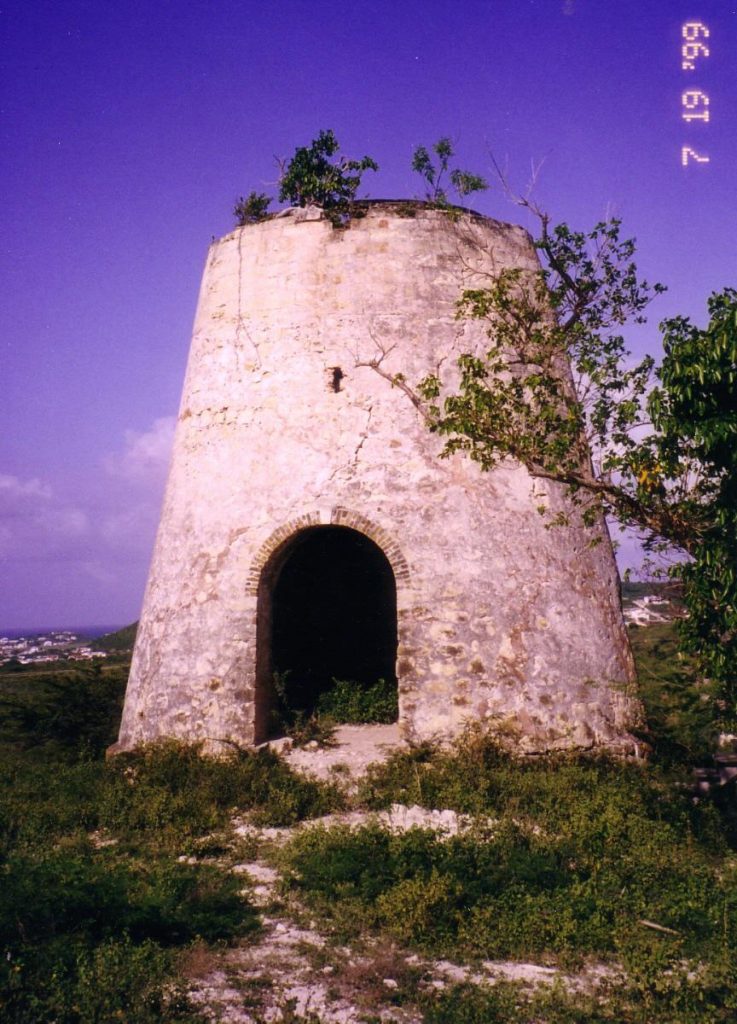About
Type: Extant
Parish: St.John
Founding date: 1750
See on Google Maps!

Current Status
The sugar mill of this estate is still intact, but more recent construction surrounds it, so it no longer commands the landscape it once did. The ruins of the estate house are also still visible, but a recent fire burnt the building to the ground. The neighboring estates were Dunbar’s (#8), Weatherill’s (#5), and McKinnon’s (#10).
Estate Related History/Timeline
The Jarvis family owned Doddington Hall in Lincolnshire, England.
The Marble Hill plantation received a Legacy award from the British Parliament of £2,482. 16s. 2d. (Antigua 38) for 199 freed slaves when Parliament abolished slavery in 1833 and set aside £20 million to compensate plantation owners for the loss of their indentured labor. The awardees were Reverend Henry Joseph Barton, William King, Benjamin Travers, and Joseph Travers. Sarah Willett Hocker (nee Ottley) was a beneficiary. Bertie Entwhistle and Martha Flemming Ottley were unsuccessful claimants.
In 1941, the Antigua Sugar Factory Ltd. cane returns were estimated at 554 tons. There were 76 peasants on the estate.
The estate house had been partially restored in 1976/77 by Dominic Habsburg, who left Antigua in 1983 after leasing the estate to Mollwyn Joseph. It is understood that Mr. Joseph received EC $129,000 from the Antigua government to repair the historic house, but it remained closed and later fell into disrepair due to theft and the ravages of free-range goats.
An American Naval Construction unit (Seabees) completely refurbished the house (unhistorically) in 1991 as a gift from the U.S. Government to be used as a drug rehabilitation and halfway house. Shortly after the opening ceremony in 1995, Hurricane Luis pounded Antigua with 140-mile-an-hour winds for 36 hours, and the Marble Hill estate house was completely destroyed. It has never been repaired since.
Enslaved People’s History
Based on contemporary research, we have little information to share about the enslaved peoples from this plantation at this time. What is known is that the Marble Hill plantation received a Legacy award from the British Parliament of £2,482. 16s. 2d. (Antigua 38) for 199 freed slaves when Parliament abolished slavery in 1833 and set aside £20 million to compensate plantation owners for the loss of their indentured labor. We will continue our quest for more information about these vital individuals.
Ownership Chronology
- 1750: Samuel Nibbs
- 1790: James Nibbs Baptized 1752. d. 1822 (1777/78 map by cartographer John Luffman.)
- 1787: A document states, “James Nibbs…leaves his Marble Hill estate to Sarah Willett Otley containing 171 acres, to have and to hold for one full year.” Vere Oliver, Vol. II.
- 1790: James Langford Nibbs d. 1822
- 1791: A letter dated November 13, 1791, says Peter Murray was manager of the estate owned by James Langford Nibbs, Esq.
- 1806: Reverend George Nibbs, the only surviving son of James Langford Nibbs
- 1822: Mrs. Nathaniel Humphrey. She was the only sister of James Langford Nibbs and “had a life interest in his plantation of Marble Hill.” James’ will gave Mrs. Humphrey the plantation upon his death in 1822, and she gave her nephew management responsibility for the “property and house at Marble Hill.” The nephew announced her death in 1824
- 1840: Bertie Entwhistle Jarvis. d. 1846
- 1843: Mrs. Bertie Entwhistle Jarvis. d. 1862. She inherited the 172-acre estate from Mr. Nibbs. She had written a letter dated June 2, 1823, complaining that Peter Murray, the estate manager appointed in 1791 by James Langford Nibbs, “had for many years shamefully neglected this property by his infirmities, that his funeral was on the 17th and he was very much esteemed.” Vere Oliver, Vol. II.
- 1872: Mrs. M. E. Jarvis (See Hart’s & Royal’s, #3, re Thomas Jarvis, same year.) 172 acres
- 1891: Mrs. Bertie Entwhistle Jarvis
- 1921: Amelia Gonsalves
- 1933: A. H. Stamers
- 1957: Syndicate Estates
- 1976-1983: Dominic Habsburg
- 1980c: Molwyn Joseph
- 1994: Drug Rehabilitation Centre, destroyed by fire and hurricanes. Only the sugar mill was left standing
- 2016: Residential area